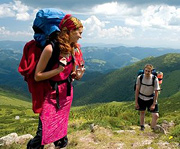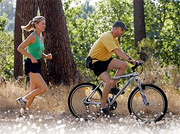To Your Health
July, 2007 (Vol. 01, Issue 07) |
|
|
Hiking
Summer is a great time to take advantage of nature's beautiful sights, and hiking is a way to experience the great outdoors while giving your body a good workout.
But hiking has its drawbacks; in particular, walking for long periods of time on uneven terrain presents the opportunity for injury and fatigue.
 Effects on the Spine
Effects on the Spine
- Shoes that do not fit properly can cause pain, and without the proper traction for a particular terrain, you could slip, trip or fall and injure your spine (or another part of your body).
- When you walk, your spine is supported by one leg at a time, which decreases your stability.
- Although not as severe as when running, contact force is still transmitted to your spine and can damage your joints.
 Prevention
Prevention
- Wear comfortable shoes with proper traction.
- Use a walking stick to take some of the pressure off your body.
- Wear flexible, custom-made orthotics that contain shock-absorbing materials and help stabilize the body.
 Running
Running
Running can exert five times a person's body weight on the feet and ankles. This force travels up the legs, through the hips to the spine and head, potentially causing muscle, joint and back pain. You must take measures to protect yourself; otherwise, your joints, cartilage and other connective tissue can get damaged - leading to arthritis or worse.
 Effects on the Spine
Effects on the Spine
- When your heel makes contact with a hard surface, it creates a shock force that travels up the legs to your spine and head, damaging joints along the way.
- Muscles in the back work hard to stabilize the body and maintain proper posture while you run.
- The forces of running jerk and compact spinal joints and discs.

